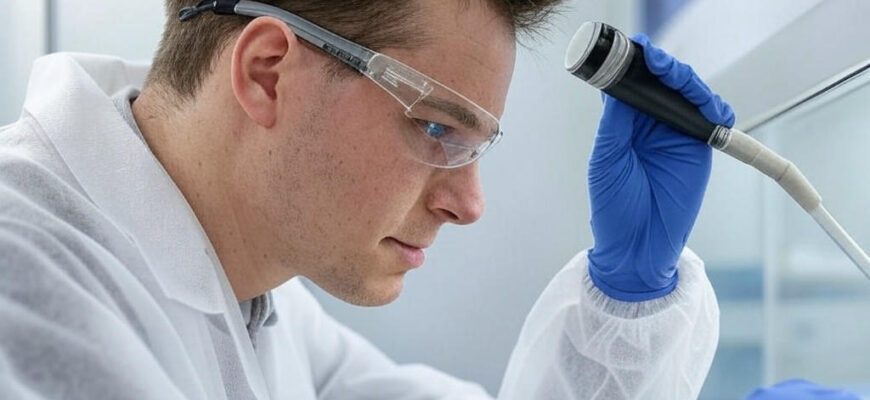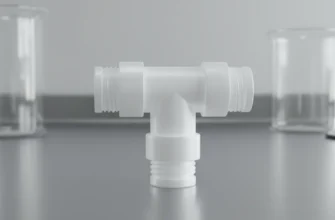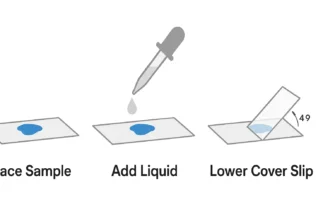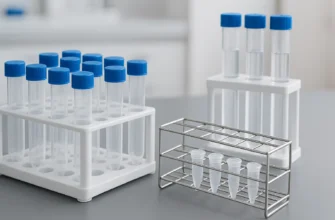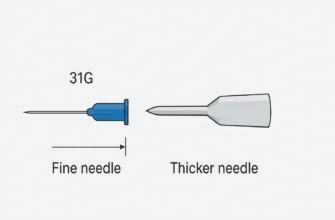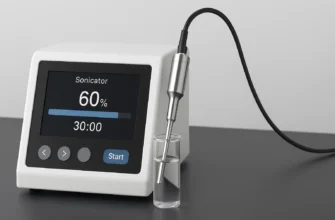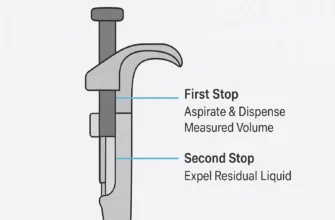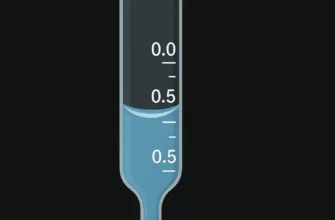Micropipettes and Tips: A Comprehensive Guide
Micropipettes are fundamental instruments in modern laboratories, enabling precise liquid handling at the microliter scale. These precision instruments, along with their disposable tips, form the backbone of accurate experimentation in various scientific fields. This comprehensive guide explores the world of micropipettes and tips, their types, proper usage techniques, and applications across different scientific disciplines.
Introduction to Micropipettes
A micropipette is a common yet essential laboratory instrument used to accurately and precisely transfer volumes of liquid in the microliter range. These instruments have revolutionized laboratory work by allowing scientists to handle extremely small volumes with high precision, which is crucial for various applications in molecular biology, biochemistry, microbiology, and clinical diagnostics.
Modern micropipettes operate based on air displacement principles, where pressing the plunger creates a partial vacuum that draws liquid into a disposable plastic tip. The precision engineering behind these instruments ensures reproducible results in sensitive experimental procedures, making them indispensable tools in contemporary scientific research.
Historical Development
The evolution of micropipettes has been remarkable since their inception. In the 1970s, Warren Gilson and professor Henry Lardy invented an adjustable micropipette that could alter air pressure according to experimental requirements, enabling scientists to precisely isolate and transfer smaller liquid volumes.
Today’s micropipettes feature advanced capabilities, including Bluetooth connectivity and automatic/robotic pipette systems. These modern systems come with specialized micropipette tips, compatible only with advanced and high-end pipettes.
Components of a Micropipette
Understanding the various components of a micropipette is essential for proper usage and maintenance. A typical micropipette consists of several key parts:
Plunger
The plunger serves two critical functions. First, it allows volume adjustment by rotating clockwise or counterclockwise to decrease or increase the volume setting. A distinct click sound at every volume change ensures perfect volume setting and prevents accidental volume changes. Second, it enables liquid aspiration and dispensing when pressed and depressed.
Volume Display Window
This component shows the volume of liquid to be aspirated or dispensed. Different micropipettes have different reading scales, depending on their volume range.
Tip Cone
The tip cone provides fitment to the tips. A pipette with a universal tip cone is preferred as it enhances compatibility with various tip brands and types.
Tip Ejector
The internal mechanism of the micropipette does not come in direct contact with the sample or liquid. Instead, a disposable micropipette tip is used. The tip ejector allows for safe, effortless, and quick ejection of tips by pressing the tip ejector button.
Types of Micropipettes
Micropipettes come in various configurations to suit different laboratory needs:
By Volume Range
- P20 (2-20 μL): Used for measuring small volumes, often the pipette of choice for loading electrophoresis gels.
-
P200 (20-200 μL): One of the easiest pipettes to set because “what you see is what you get” in terms of reading the volume display.
-
P1000 (100-1000 μL): Used for larger volumes, with the display numbers multiplied by 10 to determine the amount being measured.
By Channel Configuration
- Single-Channel Micropipettes: Used in laboratories conducting thorough research in microbiology, molecular biology, cell culture, immunology, biochemistry, analytical chemistry, genome study, and genetics.
-
Multi-Channel Micropipettes: Ideal for ELISA (diagnostic testing) as well as molecular screening studies of kinetics and DNA amplification.
By Operation Mechanism
- Air Displacement Pipettes: The most common type, using an air cushion to transfer liquids.
-
Positive Displacement Pipettes: Feature direct contact of the piston with the sample without any air cushion, recommended for difficult-to-handle samples (viscous, volatile, corrosive, dense, radioactive, extremely hot/cold).
By Volume Adjustment
- Fixed Volume Micropipettes: Set to dispense a specific, unchangeable volume.
-
Adjustable Volume Micropipettes: Allow users to set different volumes within a specified range.
By Control Method
- Manual Micropipettes: Operated by hand with mechanical controls.
-
Electronic Micropipettes: Feature electronic controls for improved precision and ergonomics, though they may have limitations in certain modes such as stepper/dispensing.
Types of Pipette Tips
The selection of appropriate tips is crucial for accurate pipetting. Various types of tips are available to meet different experimental needs:
By Filtration
Filter Tips: Feature a non-self-sealing PE filter that is free of chemical additives and allows easy uncontaminated sample retrieval when the filter is wet.
-
Non-filter Tips: Used mostly in laboratory experiments where sterility is not an important criterion.
By Packaging
Tips are available in different packaging formats:
- Racked
- Bulk
- Reloads
- Individually wrapped
By Retention Properties
- Low Retention Tips: Also called low binding tips, these have been modified to reduce the adhesion of DNA, enzymes, proteins, cells, and other sticky materials to the tip surface.
- Standard Tips: Regular tips without special retention properties.
By Sterility
- Sterile Tips: Gamma-irradiated, free of biological contaminants such as RNase/DNase, human DNA, and pyrogens. They find application in highly sensitive assays requiring a high degree of sterility.
- Non-sterile Tips: Used for general laboratory procedures where sterility is not critical.
By Dimensions
- Macro Tips: Capable of handling reagents in volumes ranging from 5 ml to 10 ml.
-
Micro Tips: Used to transfer relatively small liquid volumes, mostly in the range of 0.5 μL to 1,250 μl.
-
Ultra-Micro Tips: Used to transfer very small liquid volumes ranging from 0.5 μL to 20 μL.
By Orifice Design
- Wide Orifice Tips: Designed with a large aperture, particularly useful for eliminating cell shearing and flow resistance. With an orifice almost 70% greater than a standard pipette tip, these tips offer significant flexibility required for handling difficult-to-pipette samples, such as fragile cell lines, genomic DNA, macrophages, hepatocytes, hybridomas, and other highly viscous liquids.
- Standard Orifice Tips: Regular tips with standard aperture size.
By Length
- Short Tips: Used to fill small wells, for instance, while pipetting in a 384 or 1,536 well-plate. They offer better ergonomic properties by enabling pipetting closer to the bench, thereby minimizing arm strain.
-
Extended Length Tips: Offer significant contamination control by enabling users to reach the bottom of vessels, thereby reducing contact of the container with the pipette shaft.
By Tip Shape
- Beveled Tips: A beveled orifice prevents adherence of the sample to the tip and makes it easier to pipette every drop of sample completely. In gel loading, a beveled tip is useful in preventing accidental damage to the gel.
-
Round and Flat Tips: Flat and round tips enable easy access into vertical and horizontal electrophoresis gels. Flat tips are primarily used for loading acrylamide and agarose gels in gel electrophoresis, whereas round tips are better suited for loading SDS PAGE and agarose gels.
By Special Applications
- Gel Loading Tips: Specialized for loading acrylamide or agarose gels, as standard pipette tips can lead to significant pipetting errors.
-
Blood Sample Tips: Wide orifice tips generally used for blood and plasma samples, which contain proteins that pose the risk of wetting the surface of a pipette tip, causing foaming.
-
Repeater Pipette Tips: Used with repeater pipettes that enable multiple repetitive dispensing cycles, manufactured using high-quality virgin plastics without chemical additives to prevent contamination.
Proper Pipetting Techniques
Mastering proper pipetting technique is essential for accurate and precise liquid handling:
Basic Forward Pipetting Technique
- Set the correct volume by turning the plunger. Generally, turning clockwise reduces volume, while turning counterclockwise increases it.
-
Attach a tip by pressing the micropipette shaft firmly into the tip in the tip box. Do not touch the tip with your hands, even with gloves on, to prevent contamination.
-
Press the plunger to the first stop slowly with your thumb until the plunger stops on its own.
-
With the plunger still pressed, lower your micropipette tip (only the plastic part) into the liquid or sample you are working with, about 2-3 mm under the surface.
-
Slowly release the plunger to draw liquid into the tip. The liquid should rise without any bubbles.
-
To dispense the liquid, touch the tip to the wall of the receiving vessel and slowly press the plunger to the first stop, then continue to the second stop.
-
Keep the plunger pressed as you remove the tip from the container to avoid sucking up liquid from the receiving vessel.
-
Eject the tip into a waste container by pressing the tip ejector button.
Reverse Pipetting Technique
For viscous liquids, reverse pipetting is recommended:
- Press the plunger to the second stop to aspirate the liquid.
-
Dispense by pressing only to the first stop, leaving some liquid in the tip.
This technique provides a liquid cushion that allows faster pipetting without introducing air and is very accurate for viscous solutions.
Common Errors and Troubleshooting
Being aware of common pipetting errors can help improve accuracy and precision:
Improper Handling
Holding pipettes sideways, upside down, or pipetting outside of the volume range can damage the pipette and affect calibration. Always hold micropipettes vertically while aspirating and at a 15-60° angle while dispensing.
Tip Selection Issues
Using inconsistent tip types or brands can affect volume accuracy. It’s recommended to be consistent with the tips you use and send them with your pipettes when they’re calibrated.
Filter Tip Problems
Once filter tips get “wet,” they will block airflow, causing the volume to be off. This isn’t always a problem with filter tips but can be an issue when the filter is attached to the tip holder.
Electronic Pipette Limitations
The stepper/dispensing mode on electronic pipettes can have precision issues. If you need to dispense the same volume multiple times accurately and precisely, consider using dedicated steppers.
Temperature Effects
The warmth from holding a pipette too long in your hand can influence measurements, especially with certain brands like Gilson.
Micropipette Applications in Advanced Research
Micropipettes play crucial roles in cutting-edge scientific applications:
Cell Manipulation and Transportation
Micropipettes are essential tools for precise cell aspiration and transportation. Recent advancements include the development of control systems based on cell dynamics rather than fluid dynamics, significantly improving control performance when aspirating cells into micropipette orifices.
Single Cell Analysis
Combining micropipettes with atomic force microscopy (AFM) allows for precise 3D manipulations and nanomechanical measurements of single living cells. This integration enables researchers to quantitatively measure the viscoelastic properties (Young’s modulus, relaxation time, viscosity) of cells through AFM-based indentation assays.
Optical Tweezer-Micropipette Systems
Compact single fiber optical tweezer–micropipette systems can sort particles by differences in shape and refractive index in a completely noninvasive way while retaining flexibility, high selectivity, and precision. These systems can form compact microfluidic channels by combining micropipettes of different diameters.
Biomechanical Nanotools
Micropipette-based aspiration assays and dynamic force spectroscopies provide unprecedented mechanobiological insights with excellent live-cell compatibility. When combined with advanced microscopies, these biomechanical nanotools enable characterization of receptor-mediated cell mechanosensing and subsequent organelle behaviors at single-cellular and molecular levels.
Maintenance and Calibration
Proper maintenance and regular calibration are essential for ensuring micropipette accuracy and longevity:
Regular Calibration
Micropipettes should undergo a full preventive maintenance once a year, including complete disassembly, cleaning, seal/O-ring change as recommended, tip holder change as recommended, new grease application, and calibration verification.
Avoiding Common Maintenance Mistakes
- Don’t open up your pipettes or grease them yourself. Pipettes often need very little grease to work, and some models don’t need grease at all.
- Don’t touch the adjustment mechanisms. In some pipettes, the adjusting screw is easily accessible, but adjusting it without proper knowledge can affect calibration.
- Don’t turn the tip when putting it on tightly. The tip holder of some pipettes is attached to the handle by a thread, so twisting the tips tightly might accidentally disassemble it.
- Keep the pipette at its maximum stated value when not in use to keep the spring mechanism in its most relaxed position.
Calibration Standards
Several specifications exist for pipette calibration:
- ISO8655: Sets the same deviation volume on all calibration volumes. Not very strict but commonly used.
-
Manufacturer specs: Often the most strict specifications, used by manufacturers in their marketing.
-
ILAC MRA/ISO17011: Includes additional calculations to account for errors, increasing the tightness of the specification.
Conclusion
Micropipettes and their tips are vital tools in modern laboratory settings, enabling precise and accurate liquid handling at the microliter scale. Understanding the different types of micropipettes and tips, mastering proper pipetting techniques, and maintaining these instruments properly are essential skills for any laboratory professional.
The continuous advancement in micropipette technology—from basic manual models to sophisticated electronic systems with specialized tips—reflects the growing demands for precision and efficiency in scientific research. As research methodologies become increasingly sophisticated, micropipettes will undoubtedly continue to evolve, offering even greater precision and versatility for future scientific discoveries.
By selecting the appropriate micropipette and tip combination for specific applications and following proper techniques, researchers can ensure the reliability and reproducibility of their experimental results, ultimately contributing to the advancement of scientific knowledge across various disciplines.

